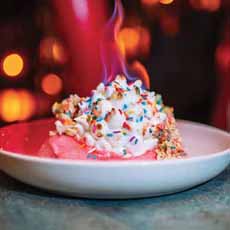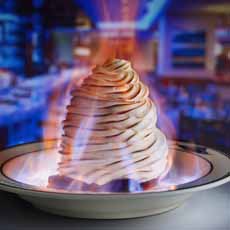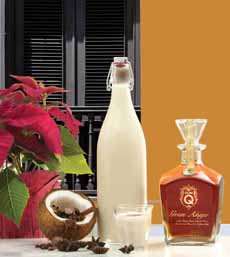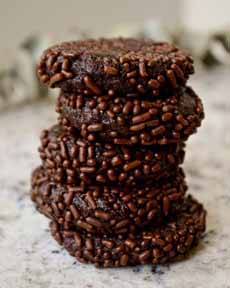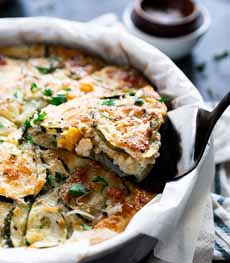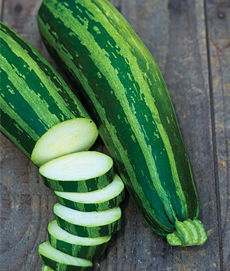|
Soups from the can, even when they’re good, can be made even better with a few added ingredients.
In this tip, we’ll show you how we enhanced one of our favorites, and inspire you to do the same.
We adore Thai chicken coconut soup (tom kha gai, translated as chicken galangal soup—photo #1).
It’s a hot and sour soup flavored with classic Thai ingredients: basil, chile paste, cilantro, coconut milk, fish sauce, galangal* (photo #3), kaffir lime leaves, lemongrass, lime juice, straw mushrooms (or shiitake) and Thai chiles, plus chicken.
It’s made creamy with coconut milk, and crispy fried chiles are sometimes added for garnish.
We’ve been getting take-out from our neighborhood Thai restaurant, but at a base of $7 for a small bowl—plus extra for proteins like chicken or shrimp—it gets pricey.
So, we searched around, and found cans of Amy’s Thai Coconut Soup. It isn’t as chock-full and rich as the restaurant version, but we adapted a recipe from Amy’s Kitchen.
Add some extra veggies, fresh herbs and protein, and serve with jasmine rice to make a complete meal.
Since most of us don’t live near an Asian grocer, this recipe with easy-to-find ingredients.
RECIPE: THAI COCONUT SOUP, TOM KHA GAI
Ingredients
3 cans Amy’s Organic Thai Coconut Soup (photo #2)
Juice of ½ fresh lime
1 cup organic tofu, cubed (substitute or add chicken or shrimp—see note)
2 tbsp tamari or low-sodium soy sauce
½ cup fresh basil leaves, torn
8 sprigs fresh cilantro, cleaned and chopped
5 shiitake or white mushrooms, sliced (straw mushrooms if you can find them)
½ cup cherry tomatoes, halved
1 cup organic jasmine rice, cooked
Optional: 1/2 cup full cream coconut milk (for creaminess—photo #4)
Optional: 1 Thai chile (or substitute), finely sliced
Garnish: cilantro, finely sliced red chile, fried chiles
NOTE: While tofu adds protein to the soup, we like to add more flavorful protein such as chicken or shrimp (scallops, mussels and fish fillets work, too). You can add a little or a lot, including a “mixed grill” of proteins, as you prefer.
Preparation
1. POUR the soup into a medium saucepan. Add the lime juice and mushrooms.
2. WARM the soup over medium heat for 20 minutes, reducing the broth to concentrate the flavors. While the soup is warming…
3. PLACE the tofu and tamari in a small, shallow bowl and toss well. Marinate for 10 minutes. Add the tofu, basil, cilantro, tomatoes and optional coconut milk to the soup.
4. SERVE immediately with a side of rice.
YOUR HOMEWORK
Take one of your favorite soups and build on it, as we’ve done here. You can add:
Additional vegetables, herbs and spices
Proteins of choice, including leftovers and sausage
Diary for creaminess
Heat
|
|

[1] This “loaded” bowl of Thai coconut soup added half of the ingredients to a can of soup.
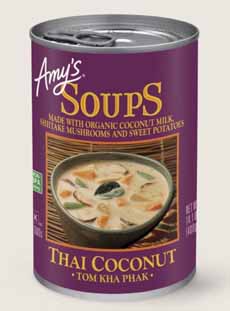
[2] It starts with this can of soup (both photos courtesy Amy’s Kitchen).
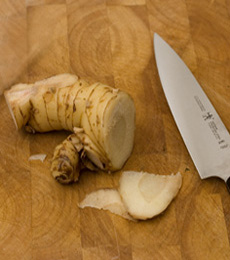
[3] Galangal, looking similar to its cousin, ginger (photo Wikipedia).

[4] Add unsweetened whole coconut milk for extra creaminess (photo courtesy Thai Kitchen).
|
*WHAT IS GALANGAL
Galangal is a rhizome, an underground shoot that is a member of the ginger family (along with turmeric and cardamom). It’s popular in Thai, Indonesian and Malaysian cooking.
Galangal has an earthy, citrusy, almost piney flavor. It is much stronger than ginger, which is pungent and spicy, with a hint of sweetness.
Galangal is also known as Thai ginger or Siamese ginger, because it resembles ginger root (photo #3). The skin is smoother and lighter than ginger and the flesh is much harder (so it can’t be grated like ginger).
THE DIFFERENT TOM (SOUPS)
The soups you’re most likely to find at Thai restaurants in the U.S. are:
Tom yum is a hot and sour soup, a broth made with with fragrant spices and herbs.
Tom kha gai or kai is a spicy and sour hot soup with a coconut milk broth.
Tom kha phak is similar to tom kha gai, with the addition of sweet potatoes and green beans.
There are many other Thai soups, of course. Scroll down here to see some of them.
|
